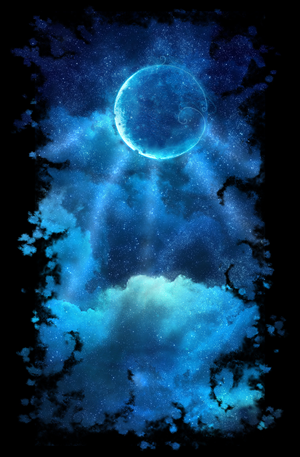
What is a Blue Moon?
There are in fact two definitions for a blue moon. According to the more recent definition, a blue moon is the second full moon in a calendar month. For a blue moon to occur, the first of the full moons must appear at or near the beginning of the month so that the second will fall within the same month (the average span between two moons is 29.5 days).
The Other Kind of Blue Moon
May 2008's blue moon qualified as such under an older definition, which is recorded in early issues of the Maine Farmer's Almanac. According to this definition, the blue moon is the third full moon in a season that has four full moons. Why would one want to identify the third full moon in a season of four full moons? The answer is complex, and has to do with the Christian ecclesiastical calendar.
Some years have an extra full moon—13 instead of 12. Since the identity of the moons was important in the ecclesiastical calendar (the Paschal Moon, for example, used to be crucial for determining the date of Easter), a year with a thirteenth moon skewed the calendar, since there were names for only 12 moons. By identifying the extra, thirteenth moon as a blue moon, the ecclesiastical calendar was able to stay on track.
How Often Does a Blue Moon Occur?
Over the next 20 years there will be about 15 blue moons, with an almost equal number of both types of blue moons occurring. No blue moon of any kind will occur in the years 2011, 2014, and 2017.
The more recent phenomenon, where the blue moon is considered to be the second full moon in a calendar month, last occurred on May 31, 2007. Two full moons in one month may occur in any month out of the year except for February, which is shorter than the lunar cycle.
The other, older blue moon event, which happens when there are four full moons in a season, last occurred in August 2005. Since this type of blue moon is reckoned according to the seasons, it can only occur in February, May, August, or November, about a month before the equinox or the solstice.
Twice in a Blue Moon
The rare phenomenon of two blue moons (using the more recent definition) occurring in the same year happens approximately once every 19 years. 1999 was the last time a blue moon appeared twice, in January and March.
The months of the double blue moons are almost always January and March. That is because the short month that falls in between them, February, is a key ingredient in this once-every-19-year phenomenon. For January and March to each have two full moons, it's necessary for February to have none at all. Since February is usually 28 days long, and the average span between full moons is 29.5 days, if a full moon occurs at the end of January, it's possible for the next full moon to skip February entirely and fall in the beginning of March.
Once in a Blue Moon
"Blue moon" appears to have been a colloquial expression long before it developed its calendrical senses. According to the Oxford English Dictionary, the first reference to a blue moon comes from a proverb recorded in 1528:
If they say the moon is blue,Saying the moon was blue was equivalent to saying the moon was made of green (or cream) cheese; it indicated an obvious absurdity. In the 19th century, the phrase until a blue moon developed, meaning "never." The phrase, once in a blue moon today has come to mean "every now and then" or "rarely"—whether it gained that meaning through association with the lunar event remains uncertain
We must believe that it is true.
Next blue moon? December 31 2009
Happy Holidays!

1 comment:
Facinating. Very well written. Thanks for sharing.
Cheers!
Post a Comment